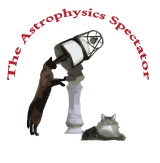
The basic layout of the site is as survey paths, which can be found under the Surveys link at the top of this and most other pages on this site. Each survey begins with a basic overview of the subject. Part of this overview include simulators of astrophysical phenomena that allow the reader to experiment with the phenomena. The later pages in a survey present the subject in greater and more mathematical depth. A path ends with research pages that describe current research projects and results in astrophysics.
The links at the top of each page are Home, which is the current home page of this site, Commentary, which is an index of short essays on topics loosely related to astrophysics, Surveys, which is the index of survey paths, Research, which is the index of research pages and the page leading to recent news items, Background, which is the index page for all background information on astrophysics, including survey pages, simulator pages, tables, bibliographic references, and lists of web resources, Previously, which is an index of previous home pages, and Site Info, which describes the site and its author, and gives contact information.
On the home page is found an addition link. This is the Store link, which leads to reviews of worthwhile books on astronomy and other relates subjects. Links on these pages enable the reader to buy these books from Amazon.com, which helps to financially sustain this web site.
Each Wednesday, a new issue of The Astrophysics Spectator is published that comprises a new home page, a new commentary, whatever news the author notices, and background, research, and simulator pages added to the survey paths. The home page acts as an index to the newly added pages. This site also has an RSS channel, whose link is given at the bottom of the right-hand column of this page.
August 24, 2005
This issue of The Astrophysics Spectator adds a new simulator to the web site. This simulator calculates the thermonuclear fusion of helium within a star. The simulator page is part of the “Stars” survey path. This week I also add a commentary to the web site.
The primary energy source of a star is hydrogen. Most stars that we see are in the hydrogen-burning stage. This energy source keeps stars like the Sun glowing for many billions of years. Stars in this hydrogen-burning stage are called main-sequence stars.
Eventually all of the hydrogen within the core of a star is converted into helium, so that the only immediately available source of energy is gravitational potential energy. When a star reaches this stage, its core gradually shrinks until the density and temperature are sufficiently to sustain the thermonuclear fusion of helium into carbon, oxygen, and other heavier elements. Stars in this stage have extended outer envelopes that make them appear as red giant stars.
The fusion of helium into carbon may seem an oddity, because carbon-12 is composed of three helium-4 nuclei. Why is the beryllium-8 stage, which would be composed of two helium-4 atoms, skipped? The answer is that beryllium-8 is at a higher energy state than two helium nuclei, so when beryllium-8 is formed in the collision of two helium-4 nuclei, it rapidly decays back into two helium-4 nuclei. This does not mean that there is no beryllium-8, only that there is a tiny amount of beryllium-8. Carbon-12 is formed when helium-4 collides with a beryllium-8 nucleus before it can decay.
Carbon is not the end product of helium fusion. Other products are nuclei that are multiples of helium-4. The principal nuclei besides carbon-12 created in helium fusion are oxygen-16 and neon-20. The carbon in our bodies and the oxygen we breathe were created long ago in stars undergoing helium fusion. The carbon and oxygen in the current generation of star, which moderates the CNO hydrogen fusion process, was also created in this way by earlier-generation stars.
The helium simulator shows how temperature affects the fusion of helium into carbon, oxygen, and neon. At low temperatures, meaning around 100 million degrees Kelvin, oxygen is the primary product, but at higher temperatures, meaning above 120 million degrees Kelvin, carbon is the primary product. The most striking effect, however, is the strong dependence of burn time on temperature. By changing the temperature by a factor of 2, the time required to fully consume helium plunges from one trillion years to less than a year.
This week I write a commentary arguing that Pluto should not be considered a planet. That such a tiny objects as Pluto is considered a planet is a fluke of history. Recent discoveries of objects of similar size as Pluto in our solar system gives us an opportunity to correct this mistake.
Publication Notice. The next issue of The Astrophysics Spectator is slated for September 7.
Jim Brainerd
Commentary
Planet Killers. In 1930 the discovery of Pluto was regarded as a great achievement, for the effort to find Pluto was spurred by theoretical predictions of a ninth planet. But Pluto is embarrassingly small, too small to be the predicted ninth planet. Now we are finding more and more Pluto-sized objects beyond the orbit of Neptune. We should take the hint, remove Pluto from the list of planets in the Solar System, and simply consider it as one of the largest planetoids in the Kuiper Belt. (continue)
Simulator
Helium Fusion Simulator. This simulator is a Java applet that follows in time the nuclear fusion of helium into carbon, oxygen, and neon. The reader can adjust the temperature of the gas undergoing nuclear fusion. At the start of a simulation, the gas to undergo fusion is pure helium. The simulator calculates the change in composition up to the time that all of the helium is exhausted. (continue)

RSS Channel
